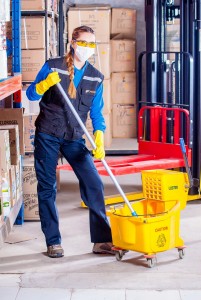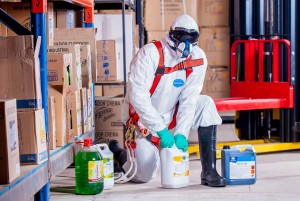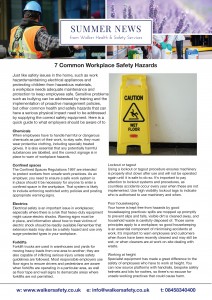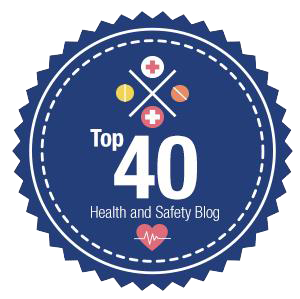

In each newsletter we will be exploring the top 8 pieces of workplace health and safety legislation that you should be aware of.
In this edition of our newsletter, we have chosen to talk about Manual Handling Operations Regulations 1992 and Personal Protective Equipment at Work Regulations 1992.
Manual Handling Operations Regulations 1992
Under these regulations, to protect your workforce, you are required to:
- Avoid, where reasonably possible, the necessity for employees to carry out manual handling activities that involve the risk of injury.
- Produce risk assessments so the chance of injury through manual handling is reduced.
- Ensure employees involved in this work are given information on how much each load weighs.
- You should also consider, in the risk assessment, an individual’s personal characteristics, such as their strength and understanding of how to lift safely.
Personal Protective Equipment at Work Regulations 1992
This section outlines that as an employer, you must:
- Make sure appropriate personal protective equipment (PPE)is supplied without cost to the employee. PPE includes safety helmets, protective goggles, facemasks, gloves, ear defenders, air filters, protective footwear and overalls.
- Ensure PPE is suitable for the specific types of risk in the workplace environment.
- Give workers information, instruction and training on the use of PPE.

7 Common Workplace Safety Hazards
Just like safety issues in the home, such as  maintaining electrical appliances and protecting children from hazardous materials, a workplace needs adequate maintenance and protection to keep employees safe. Sensitive problems such as bullying can be addressed by training and the implementation of proactive management policies, but other common health and safety hazards that can have a serious physical impact need to be addressed by supplying the correct safety equipment. Here is a quick guide to what employers should be aware of to ensure workplace safety.
maintaining electrical appliances and protecting children from hazardous materials, a workplace needs adequate maintenance and protection to keep employees safe. Sensitive problems such as bullying can be addressed by training and the implementation of proactive management policies, but other common health and safety hazards that can have a serious physical impact need to be addressed by supplying the correct safety equipment. Here is a quick guide to what employers should be aware of to ensure workplace safety.
- Chemicals
When employees have to handle harmful or dangerous chemicals as part of their work, to stay safe, they must wear protective clothing, including specially treated gloves. It is also essential that any potentially harmful substances are labelled, and the correct signage is in place to warn of workplace hazards.
- Confined spaces
The Confined Spaces Regulations 1997 are intended to protect workers from unsafe work practices. As an employer, you need to ensure a safe work system is in place should it be necessary for anyone to enter a confined space in the workplace. That system is likely to include enforcing restricted entry policies and posting appropriate warning signs.
- Electrics
Electrical safety is an important issue in workplaces; especially where there is a risk that heavy-duty equipment might cause electric shocks. Warning signs must be in place, and information about how to treat victims of electric shock should be readily available.
Remember that extension leads may also be a safety hazard and use only surge-protected types in your workplace.
- Forklifts
Forklift trucks are used in warehouses and yards for moving heavy loads from one area to another; they are also capable of inflicting serious injury unless safety guidelines are followed. Most responsible employers use floor signs to ensure drivers and pedestrians are aware when forklifts are operating in a particular area, as well as floor tape and wall signs to demarcate areas where forklifts are not permitted.
- Lockout or tagout
Using a lockout or tagout procedure ensures machinery is properly shut down after use and will not be operated again until it is safe to do so. It’s important to pay attention to lockout systems and procedures, as countless accidents occur every year when these are not implemented. Use high visibility lockout tags to indicate who is authorised to use machinery and when.
- Poor housekeeping
Your home is kept free from hazards by good housekeeping practices: spills are mopped up promptly to prevent slips and falls, visible dirt is cleaned away, and household waste is carefully disposed of. Those same principles apply to a workplace; so good housekeeping is an essential component of minimising accidents at work. It’s important to warn employees and customers when floors have been recently cleaned and may still be wet, or when cleaners are at work on-site dealing with waste.
- Working at height
Specialist equipment has made a great difference to the safety of employees who have to work at height. You can now source platforms with handrails, bespoke safety helmets and kits for roofers, so there’s no excuse for unsafe working practices that could cause harm.

The Importance of a Clean Workplace
 Maintaining high levels of hygiene should be an essential element of how any workplace operates. As an employer, the Health and Safety at Work Act 1974 requires you to have a general duty to ensure the health, safety and welfare of all your employees, so far as is ‘reasonably practical.’
Maintaining high levels of hygiene should be an essential element of how any workplace operates. As an employer, the Health and Safety at Work Act 1974 requires you to have a general duty to ensure the health, safety and welfare of all your employees, so far as is ‘reasonably practical.’
The issue of hygiene is a part of this legislation, so you need to be sure you are providing the facilities and information for your employees to create a hygienic and clean workplace.
Why is workplace hygiene important?
There are potential dangers for any workplace if there is little or no emphasis on why hygiene is important. Primary among these risks is the possibility of infection, whether it’s through poor personal hygiene, slapdash office cleaning or badly managed washroom facilities. You can prevent many of these problems by having a strategy for maintaining a hygienic workplace.
Personal hygiene
This refers to the habits, cleanliness and appearance of your employees. It can be a sensitive area for employers and managers, so an official policy can diffuse any awkwardness by setting down exactly what is expected from everyone. Depending on your business, there may be options to provide shower facilities if employees exercise before work or rely on a bike for transport, and you can ask that hair washing and grooming facial hair is a part of usual personal hygiene for work. Hand washing and the use of hand sanitisers are also key tools to help prevent the spread of illness.
Washroom facilities
Your policy on hygiene requirements should ensure that washrooms equipped with running cold and hot water are provided for all employees. You should also provide hand soap, toilet paper and towels for drying hands. This allows employees to attend to their personal hygiene when they have finished using the facilities. If you contract the cleaning of toilets and washrooms to an outside agency, you should be clear about the levels of cleanliness you require and how often cleaning should be done.
Kitchen
Kitchens can be a health risk if proper cleanliness is not observed. Any area where food is prepared or hot drinks are made should have a high level of cleaning, including preparation surfaces, utensils and cups, mugs, plates and cutlery, where provided. Your employees are entitled to complain if they consider there is a health risk through poor maintenance and cleaning of the kitchen area, but you can also encourage them to take responsibility to protect themselves and practice a good hygiene regime.
Office cleanliness
Employees should be encouraged to be responsible for cleaning and maintaining their own work areas or workstation. This can be part of your hygiene policy so everyone is aware of it and agrees with it. Surfaces can be cleaned with disinfectant to reduce the possibility of bacterial infection, and desks should be kept tidy and as clutter-free as possible. If employees have individual bins, it’s important to ensure these are emptied on a daily basis.
Good hygiene makes good sense
When your employees are aware of why it is important to have a hygienic workplace, they are more likely to follow your policy guidelines and create a pleasant and safe environment in which to do their jobs. If everyone is vigilant, sickness levels in the workplace can be significantly reduced.

Carrying out a COSHH Assessment
 COSHH – Control of Substances Hazardous to Health – falls under the Control of Substances Hazardous to Health Regulations 2002. It requires that employers either prevent or reduce their staff’s exposure to materials that are dangerous to their health.
COSHH – Control of Substances Hazardous to Health – falls under the Control of Substances Hazardous to Health Regulations 2002. It requires that employers either prevent or reduce their staff’s exposure to materials that are dangerous to their health.
Many substances that are health hazards may appear obvious, such as chemicals and radiation, but you should also be aware that other substances can be harmful. Chemicals will have labels to warn you of their toxicity and danger, but other dangers include fumes and dust from sanding wood or from cutting silica. Bacteria also pose threats, and asbestos still appears in older buildings and should be removed safely.
In terms of health and safety, you must protect your employees from the potentially dangerous consequences of handling, manufacturing or being in areas where there are hazardous substances.
Harmful substances can get into the body in a number of ways. They could be breathed in or get onto the skin, thus damaging it, or in certain situations, they may permeate the skin, and enter the body that way. There is also a risk of swallowing a harmful substance, and you need to understand the effects of exposure by any of these routes.
Other considerations are how long people work with the substance and how often. Also be aware of those who could be exposed even if they do not work directly with a hazardous substance. It’s not just your workforce who could be affected, but also contractors, maintenance workers and other visitors, including members of the public. Cleaners or other part-time staff undertaking specific tasks may also be at risk of accidental exposure.
Legally, you must protect your employees with safe working practices, appropriate training and the right personal and protective equipment when required. Check legislation and regulation to keep your workforce safe and to protect your business.
Workplace Temperatures
It may not happen very often, but when the UK is sweltering in a heatwave it’s not always everyone’s idea of bliss.
There are regulations that govern the temperature of indoor workplaces, these are covered by the Workplace (Health, Safety and Welfare) Regulations 1992, they state that the minimum indoor workplace temperature should be at least 16C. If the work involves what is called ‘rigorous physical effort’, then the minimum temperature should be at least 13C.
However, the specified minimum temperatures are not absolute legal requirements, but the employer does have a duty to ensure staff work in reasonable comfort.
In terms of a maximum working temperature, the HSE do not specify a specific limit as high temperatures can vary in different workplaces – for example a kitchen and glass works. In high-temperature working environments such as these, the HSE says that it is still possible for employees to work safely providing that all necessary safety controls are in place.
Here are a few suggestions that employers could do:
- Utilise air-conditioners by replacing hot air with cold, or vice-versa
Use humidifiers to dehumidify or humidify the air in the workplace
Increase ventilation in the workplace, or redirect air movement onto or away from employees
Put up barriers to either shield or insulate the work area, or restrict access to certain areas
If protective clothing is worn, then employers should ensure that employees are not wearing too much than is required to be safe
Review the rules and propose alternative uniforms / dress codes to improve levels of comfort e.g. short sleeves
Make sure employees are given appropriate training and provided with supervision
Seek professional medical advice for any ‘at risk’ employees e.g. those who are pregnant, are on medication or have an illness or disability
Health and safety myths
- After eating a meal in a restaurant, a diner requested a toothpick but was told he could not have one on health and safety grounds. The panel reassured him: “There is no health and safety regulation which stops toothpicks being handed out in a restaurant… whether or not to provide toothpicks is about cost and customer service, not health and safety.”
- A council emailed an instruction to remove a flag from the inside of one of their windows stating that it breached health & safety legislation. In fact, it was the council’s own policies rather than legislation that led to the worker receiving the email.
If you have any questions relating to this newsletter, please contact Walker Health and Safety Services Limited. Info@walkersafety.co.uk 08458340400

Want to share this newsletter?
If you would like to print this newsletter we have created a formatted PDF version. You can download it here, print and distribute it accordingly.
PRINT PDF VERSION




 Networked mobile devices, cloud-based data management and 4G networks mean we can now work almost anywhere. Flexible working can save costs and improve the work-life balance of employees, resulting in more staff working while travelling and away from the office. This means an increasing use of mobile devices (laptops, tablets and smartphones).
Networked mobile devices, cloud-based data management and 4G networks mean we can now work almost anywhere. Flexible working can save costs and improve the work-life balance of employees, resulting in more staff working while travelling and away from the office. This means an increasing use of mobile devices (laptops, tablets and smartphones).












